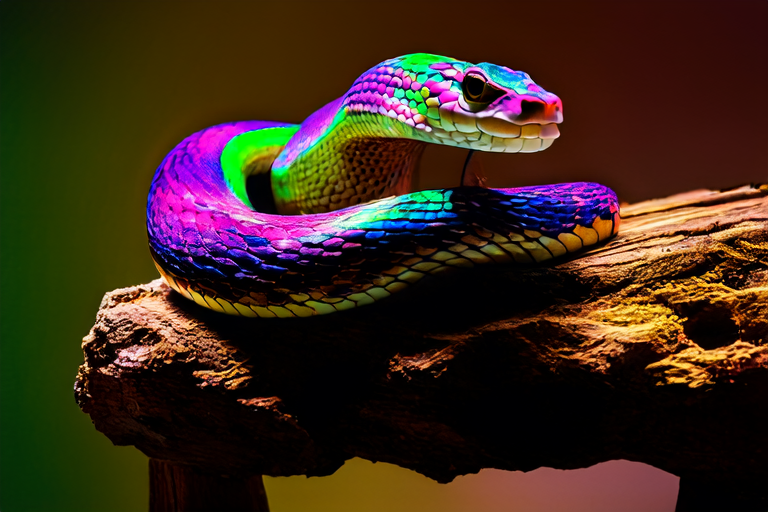Ultimate Care Guide for Rainbow Boa
Introduction to Rainbow Boa
The rainbow boa (Epicrates cenchria) is a popular choice among reptile enthusiasts due to its striking appearance and relatively easy care requirements. Native to Central and South America, including regions like Brazil, Guyana, and Venezuela, this snake thrives in tropical rainforests. With its smooth, glossy scales that often display iridescent hues under certain lighting conditions, the rainbow boa is truly a sight to behold.
Rainbow boas can grow up to 6 feet (1.8 meters) in length and come in various color morphs. Their most notable feature is their shiny, almost metallic-like appearance, which gives them their name. They are known for their gentle temperament and are generally docile when handled properly, making them ideal pets for experienced snake owners.
In the wild, rainbow boas are primarily nocturnal, spending much of their time hiding in dense vegetation or underground burrows during the day. They are excellent swimmers and can often be found near water sources. In captivity, they tend to be more active during the evening hours, although individual behavior may vary.
Setting Up the Habitat
Temperature and Humidity
Maintaining an appropriate temperature gradient within the enclosure is crucial for the health of your rainbow boa. The warm side should be around 88-92°F (31-33°C), while the cool side should be between 78-82°F (25-28°C). A basking spot of approximately 95°F (35°C) can also be provided using a heat lamp or ceramic heater. Ensure that there is no direct contact between the snake and the heat source to prevent burns.
Adequate humidity levels are essential for proper shedding and overall well-being. Aim for a humidity range of 60-70%. You can achieve this by misting the enclosure daily or using a humidifier. It’s important to monitor both temperature and humidity regularly with reliable thermometers and hygrometers.
Lighting
While rainbow boas do not require UVB lighting, providing a 12-hour light cycle can help regulate their circadian rhythms. Use a low-wattage fluorescent bulb or LED strip lights placed outside the enclosure to avoid overheating. Ensure that the light fixture is securely mounted and cannot be knocked over by the snake.
Habitat Setup
The enclosure should provide ample space for the snake to move around comfortably. For juveniles, a 20-gallon tank is sufficient; adults will need at least a 40-gallon tank. Include several hiding spots made from half logs, cork bark, or plastic hides. These hideouts should be large enough for the snake to fully enter but small enough to feel secure. Adding live or artificial plants enhances the aesthetic appeal and provides additional hiding places.
A water bowl large enough for soaking should always be available. Change the water daily to maintain cleanliness. Substrate options include coconut fiber, cypress mulch, or paper towels for easier cleaning. Avoid using sand or gravel as they pose ingestion risks.
Dietary Requirements
Food Types
Rainbow boas are carnivorous and feed mainly on rodents such as mice and rats. Juvenile snakes can start with pinky mice (newborn mice) every 5-7 days. As they grow, increase the size of prey proportionally until reaching adult feeding intervals. Adults typically eat one appropriately sized rodent every 10-14 days.
Feeding Frequency
Monitor your snake’s body condition and adjust feeding frequency accordingly. Overfeeding can lead to obesity, while underfeeding may cause health issues. Always offer pre-killed or frozen-thawed prey to reduce the risk of injury to both the snake and the feeder animal.
Nutritional Balance
To ensure a balanced diet, consider supplementing with calcium and vitamin D3 powders occasionally. Consult with a veterinarian specializing in exotic animals for specific recommendations based on your snake’s age and size.
Daily Care Tips
Cleaning
Regular cleaning helps maintain hygiene and prevents bacterial growth. Spot clean the enclosure daily by removing soiled substrate and uneaten food. Perform a thorough cleaning once a week, replacing all substrate and disinfecting surfaces with reptile-safe products. Allow the enclosure to dry completely before reintroducing the snake.
Health Checks
Perform routine health checks by examining the skin for signs of cuts, abrasions, or discoloration. Check the eyes for cloudiness or discharge. Regularly inspect the mouth for any abnormalities. Weigh your snake monthly to track growth patterns and identify potential weight loss issues early.
Preventing Common Diseases
Proper husbandry practices significantly reduce the risk of illness. Maintain optimal environmental conditions and quarantine new additions to prevent disease transmission. Common ailments include respiratory infections, scale rot, and parasites. Seek veterinary assistance promptly if you notice unusual symptoms.
Reproduction Information
Rainbow boas reach sexual maturity at around 2-3 years old. Breeding season typically occurs between October and December. Introduce males and females into separate enclosures for a few weeks prior to pairing to stimulate breeding behavior. After successful mating, females will gestate for approximately 6 months before giving birth to live young.
Clutch sizes vary but usually range from 8 to 20 offspring. Neonates should be housed individually in small enclosures with appropriate temperatures and humidity levels. Feed them appropriately sized pinky mice every 4-5 days. Monitor their development closely and separate sexes once they reach maturity to prevent accidental breeding.
In conclusion, providing proper care for a rainbow boa requires attention to detail but offers rewarding companionship. By understanding their needs and following these guidelines, you can ensure a long, healthy life for your pet.
